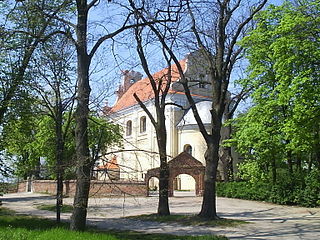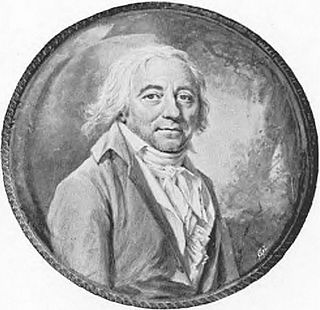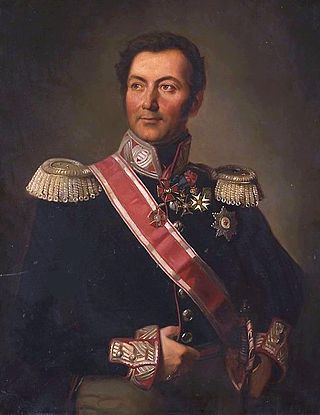This article needs additional citations for verification .(February 2016) |


Wincenty Fryderyk de Lesseur, or Lesserowicz (1745, Warsaw - 31 May 1813, Warsaw) was a Polish painter, miniaturist, pastelist and caricaturist.
This article needs additional citations for verification .(February 2016) |


Wincenty Fryderyk de Lesseur, or Lesserowicz (1745, Warsaw - 31 May 1813, Warsaw) was a Polish painter, miniaturist, pastelist and caricaturist.
His father was a French army officer, stationed in Warsaw after the War of the Polish Succession. [1] He received formal art education from Marcello and Johanna Bacciarelli. [2] During a brief stay in Vienna, he worked with Heinrich Füger.
His primary patron (and customer) was King Stanisław August Poniatowski. After 1787, he served as a chamberlain at the court. [1] By 1804, he was sufficiently well-off to settle on his own small property near Kozery.
He was renowned for his ability to create small watercolors or gouaches on ivory, using a pointillistic style that created the effect of smoothness.
In addition to portraits of the King, he painted portraits of other European monarchs, national heroes, artists, scholars, and aristocratic families and their friends. He also made miniature copies of the works of Bacciarelli, Josef Grassi and Jan Chrzciciel Lampi. [1]
Among his students were Maciej Topolski and Waleria Tarnowska. [1] A large collection of his miniatures which was owned by the Tarnowski family may now be seen at the Polish Museum, Rapperswil.

Maria Gabriela Stefania Korwin-Piotrowska (1857–1921), known as Gabriela Zapolska, was a Polish novelist, playwright, naturalist writer, feuilletonist, theatre critic and stage actress. Zapolska wrote 41 plays, 23 novels, 177 short stories, 252 works of journalism, one film script, and over 1,500 letters.

Princess Zofia Czartoryska was a Polish noblewoman.

Stanisław Samostrzelnik was a Polish Renaissance painter, miniaturist, decorator and Cistercian monk from Kraków, Poland. He was the first Polish painter known by name who painted in the Renaissance style. There are many frescos by him in the churches of southern Poland. The most distinguished can be seen in the Cistercian monastery in Mogiła. He is also recognized for his portrait of Bishop Piotr Tomicki in the portrait gallery of the Church of St. Francis of Assisi, Kraków.

Halina Birenbaum is a Polish-born Israeli Holocaust survivor, writer, poet, translator and activist.

Franciszek Ksawery Lampi, also known as Franz Xaver Lampi, was a Polish Romantic painter born in Austria of ethnic Italian background. He was associated with the aristocratic circle of the late Stanisław II Augustus, the last Polish king before the foreign partitions of Poland. Lampi settled in Warsaw around 1815 at the age of 33, and established himself as the leading landscape and portrait artist in Congress Poland soon after Napoleon's defeat in Russia.

Marcello Bacciarelli was an Italian-born painter of the late-baroque and Neoclassic periods active in Poland and the Polish–Lithuanian Commonwealth.

The Palace on the Isle, also known as the Baths Palace, is a classicist palace in Warsaw's Royal Baths Park, the city's largest park, occupying over 76 hectares of the city center.

Antoni Stanisław Brodowski was a Polish painter in the Classical style.

Żerków is a town in Jarocin County, Greater Poland Voivodeship, Poland, with 2,122 inhabitants (2010). It is located 53 kilometres (33 mi) east of the regional capital of Poznań.

The Ester Rachel and Ida Kaminska Jewish Theater is a state theatrical institution in Warsaw, Poland. It was named after the Polish-Jewish actress Ester Rachel Kamińska, who was called the "mother of Yiddish theater," and her daughter, the Academy Award-nominated actress Ida Kamińska. Ida Kamińska directed the theater and acted in its productions from the time of its founding until 1968.

Johann Baptist von Lampi the Elder was an Austrian-Italian historical and portrait painter. He settled in the Russian Empire after the third and final partition of Poland, enticed by an extremely generous offer from the Tsar.

Alexander Kucharsky also Alexandre Kucharsky, was a Polish portrait painter who spent his adult life in France. He himself used the spelling Kucharsky, but Kucharski is also often used. In the past, in France, the name has been given as Couaski.

Anna Bilińska was a Polish painter, known for her portraits. A representative of realism, she spent most of her life in Paris, and is considered the "first internationally known Polish woman artist."

Equestrian Portrait of Count Stanislas Potocki is an oil painting on canvas completed by the French Neo-Classical painter Jacques-Louis David in 1781. A large-scale equestrian portrait, the work depicts a Polish politician, nobleman, and writer of the Enlightenment Period, Stanisław Kostka Potocki. The artist shows Potocki on horseback and wearing the sash of the Polish Order of the White Eagle. As Potocki tips his hat in a welcoming gesture to the viewer, the horse bows, while a dog can be seen barking in the lower left-hand corner of the painting.

Maciej Masłowski was a Polish art historian.

Franciszek Dzierżykraj Morawski was a divisional general in the Polish army, a minister of war during the November Uprising, poet, literary critic, translator, and playwright.

Waleria Tarnowska was a Polish patron of the arts and painter in her own right, known for miniatures, numerous portraits, religious paintings and drawings.

The Girl in a Picture Frame is a 1641 oil on panel painting by the Dutch artist Rembrandt. It is also known as The Jewish Bride and The Girl in a Hat. With The Scholar at the Lectern and Landscape with the Good Samaritan, it is one of three Rembrandt paintings in Polish collections. It is currently located at the Royal Castle in Warsaw.

Józef Kosiński was a Polish portrait and miniature painter.
Johanna Juliana Friederike Bacciarelli, née Richter, was a German miniaturist, pastelist and court painter to the Polish kings.
![]() Media related to Wincenty de Lesseur at Wikimedia Commons
Media related to Wincenty de Lesseur at Wikimedia Commons